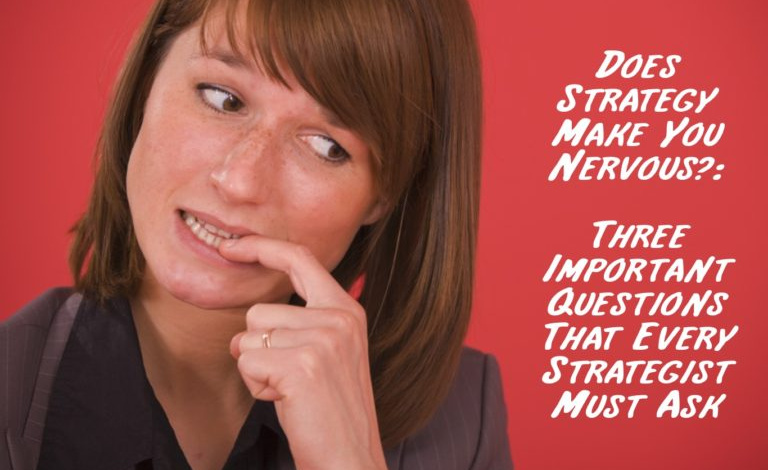Does Strategy Make You Nervous?: Three Important Questions That Every Strategist Must Ask

Can we be completely honest and transparent for just a minute? Doesn’t “strategy” often feel like a four-letter word? (I know that it actually contains more than four letters, but you get the point.) Doesn’t the thought of building strategy for your organization—one that is practical and motivating—make you feel anxious and even a little bit nauseous?
You may have answered in the affirmative, and you may have already perused the proliferation of articles and books on Strategic Thinking and Strategic Planning that claim to contain the magic elixir. If so, you’re likely reeling from the varied and sometimes contradictory approaches from many of these “strategy gurus.”
“In my experience, leaders and strategists are struggling because their practices are outdated and antiquated; they no longer suffice in the face of accelerating volatility, uncertainty, complexity, and ambiguity (VUCA).”
Should you look for uncontested strategies in a “blue ocean,” or strengthen your existing strategies in the tried and true “red oceans”? Some modern practitioners believe strategy works best as an art or a game, while more traditional experts frame it as a war or a military campaign. There are even books that tell us that our strategy needs a strategy. (No wonder strategy experts in our companies are pulling out their hair!) And our list wouldn’t be complete without a seemingly endless collection of authors that pose the most obvious question of all: “What is a strategy?” (A great question, right?)
Could it be that this plethora of strategy books, articles, and workshops are a frantic attempt to somehow make traditional strategic practices relevant in a rapidly changing reality? In my experience, leaders and strategists are struggling because those practices are outdated and antiquated; they no longer suffice in the face of accelerating volatility, uncertainty, complexity, and ambiguity (VUCA).
In order to create strategy that works in this VUCA world, I’ve pinpointed three critical questions that your business or organization must address.
- Is what you’re calling strategy actually something else altogether?
Creating meaningful and effective strategy is hard, and takes a great deal of effort, time, and resources. For this reason, many small- to medium-sized companies (and dare I say many large companies as well) will proudly share their strategic plan with me only to reveal that there is no actual strategy involved. To be sure, there are colorful charts. And bullet points. And organizational “pillars” or areas of focus. And those documents that they share with me definitely include the company or organizational mission, and even an extensive vision statement that expounds on the exciting goals that the company wants to accomplish. All of these things look great, but they don’t equate to effective strategy that helps an organization accomplish its mission, goals, and vision.
A strategy is a plan of action, or the method through which an organization achieves its desired outcomes or business model. Don’t mistake having amazing ideas with the purposeful and intentional ways in which you will actually be able to achieve your short-term goals and long-range vision.
- Does your company or organization know how to build adaptive, resilient, and transformative strategy?
As strategy guru Karl Moore noted,
“It seems the relatively stable world of my corporate career has gone the way of the dodo… the day of the 5 year and even 2 year plans has faded and emergent strategy is the reality in most industries that I work with. You must be much more fleet of foot, strategic flexibility [emphasis mine] is what we are looking for in most industries. The boundaries are more fluid now. For many, albeit not all, knowing what industry you are in is not as clear cut as it once was.”
In the landscape of Moore’s “emergent strategy,” we should hold tight to our long-term vision, but we must be willing to let go of our rigid and linear strategies at a moment’s notice if we hope to achieve those visions. Gone are the days when we could create strategy that would go unchallenged for long periods of time. In an environment that is much more transparent, convergent, and disruptive than ever before, our strategies must contain pathways that allow us to respond to new trends or changes in values, and that promote breakthroughs to our company’s next stage of growth.
- Is your company missing a critical step in the strategy-building process?
Many companies today have learned that Strategic Planning can only be done properly once leadership has engaged in Strategic Thinking. Strategic Thinking can loosely be defined as the practice of gaining business insights and competitive intelligence before deciding on the specific plans that will make an organization most effective within its industry.
Though adding the insights of Strategic Thinking to your existing Strategic Planning processes is good, it’s not enough in an environment of exponential change. If Strategic Planning is the “what” of an organization’s strategy process, and Strategic Thinking is the “how,” then Strategic Foresight is the “why” that is so critical to success in a VUCA world.
Strategic Foresight can be defined as the practice of exploring multiple alternative futures that cover a range of probable, possible, provocative, and preferred outcomes. If today’s businesses are being disrupted from outside of their conventional boundaries—think of famous examples from the music industry (Apple), the automotive industry (Uber), and even the staunchly traditional industry of finance (Blockchain)—then we must intentionally look broadly across social, technological, economic, environmental, and political forces of change before we attempt to think strategically about our areas of focus, and certainly before we build any plans for our specific organizations.
“We should hold tight to our long-term vision, but we must be willing to let go of our rigid and linear strategies at a moment’s notice if we hope to achieve those visions.”
If you are stuck in the old practice of Strategic Planning, then you are probably intimately familiar with at least one of the questions listed above. If you fail to address any of these questions, you are likely to experience “strategic fatigue,” and that should definitely present you with a very good reason to be extremely nervous.
Fortunately, the cure for strategy-induced nausea is simple: determine that you are going to differentiate your strategy from your vision, create strategy that is adaptive and resilient, and integrate the critical skillset of Strategic Foresight before you make any more plans.
P.S. You counted the number of letters in the word “strategy,” didn’t you?

Frank Spencer
Co-Founder
Creative Director
In 2009, Frank founded Kedge – a global foresight, innovation, and strategic design firm which pioneered TFSX. Throughout his career, Frank has worked as a leadership coach and developer with entrepreneurs, social communities, networking initiatives, and SMEs, helping them in areas such as development, innovation, and networking.
Read More
